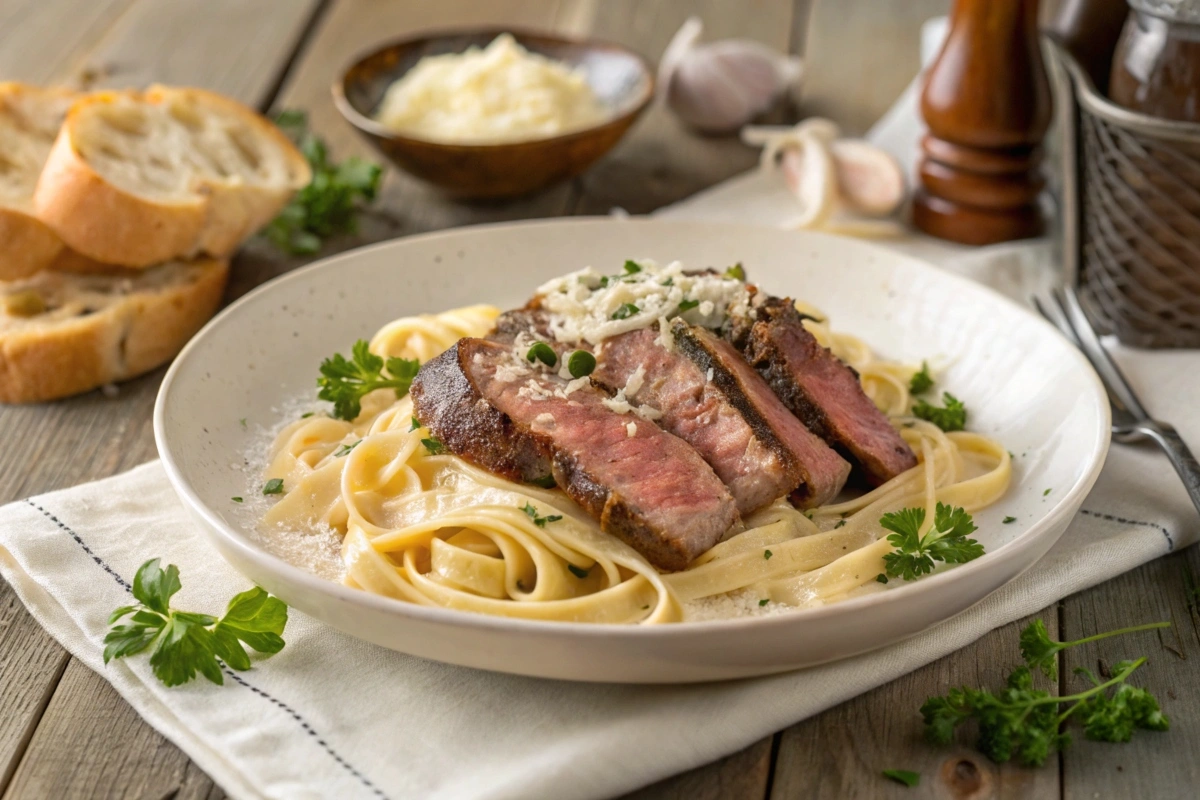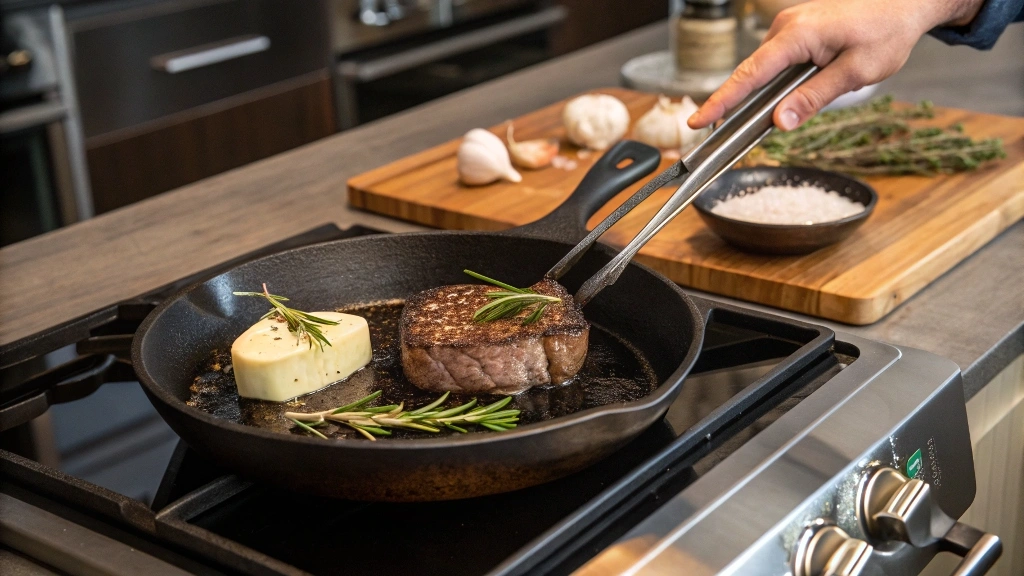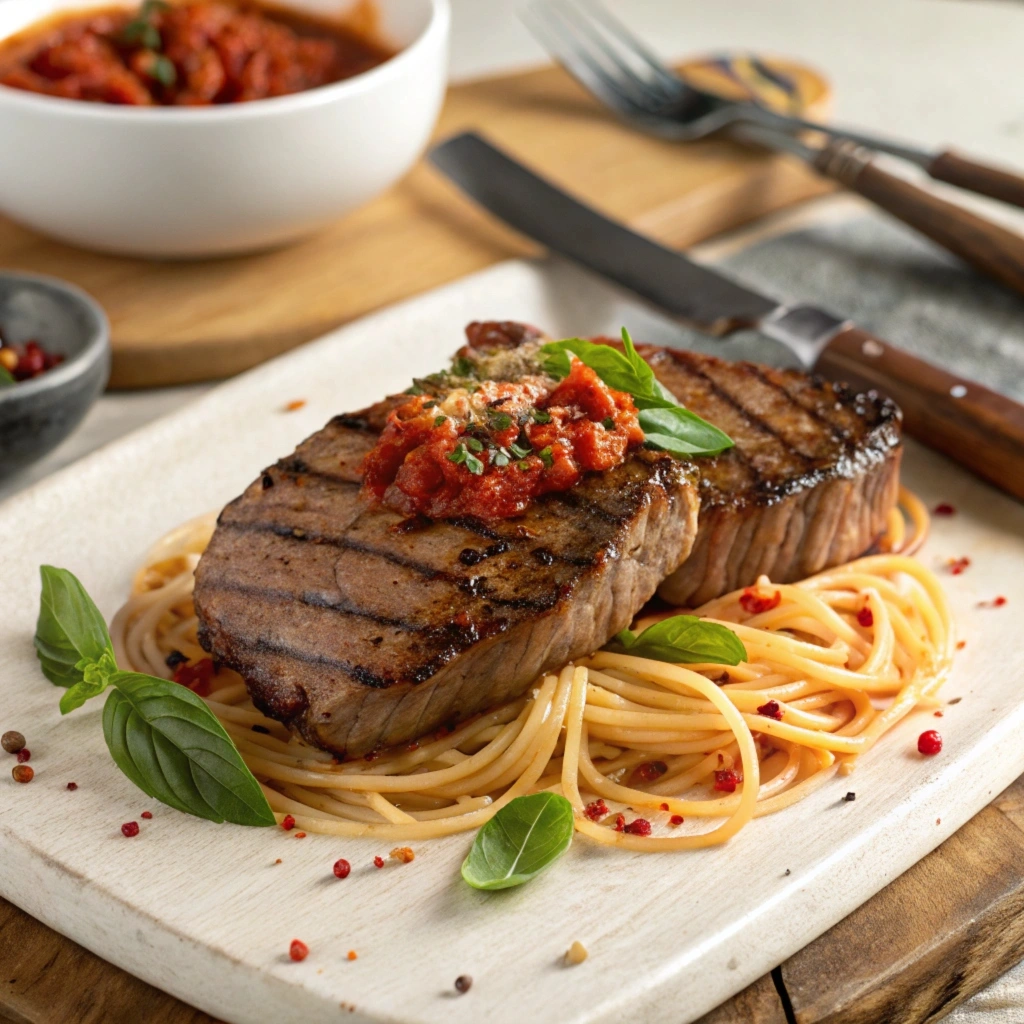When it comes to elevating a hearty pasta dish, few additions rival the rich, savory delight of perfectly cooked steak. Pairing steak with pasta not only adds protein but also layers in luxurious flavor and texture that can transform a simple meal into a gourmet experience.
However, not all steak cuts are created equal, especially when paired with pasta. The choice of cut can significantly influence the dish’s overall harmony, ensuring the steak enhances the pasta’s flavors rather than overpowering them.
This guide focuses on helping you navigate the world of steak cuts to find the perfect match for your pasta creations. Whether you’re crafting a creamy Alfredo or a zesty marinara, choosing the right steak cut can make all the difference. Let’s dive into the best options and how to prepare them for a pasta pairing that’s nothing short of perfection.
What Are Steak Cuts?
Steak cuts refer to the specific portions of beef derived from various parts of the cow, each possessing unique characteristics in terms of texture, flavor, and fat content. These cuts are broadly classified into categories such as tender cuts, lean cuts, and marbled cuts based on their muscle composition and the presence of fat, also known as marbling.
Tender cuts like the filet mignon are prized for their softness, while lean cuts like sirloin offer a firmer texture with less fat. Marbled cuts, such as ribeye, are rich in flavor due to their intramuscular fat, which melts during cooking, adding succulence and depth to the dish.
The choice of steak cut is pivotal, as it directly affects the flavor, cooking outcomes, and the overall dining experience. When paired with pasta, the right cut ensures a balance of flavors and textures, complementing the sauce and pasta rather than overwhelming it.
Popular Types of Steak Cuts
Ribeye
Known for its generous marbling, ribeye is exceptionally flavorful and juicy. Its rich fat content pairs well with creamy or cheesy pasta sauces, creating a decadent combination.
Filet Mignon
The epitome of tenderness, filet mignon is a lean yet buttery cut that pairs beautifully with light, herbaceous pasta dishes. Its mild flavor allows subtle sauces to shine.
Sirloin
A versatile and moderately tender cut, sirloin has a robust beefy flavor that complements bold tomato-based sauces. It’s a cost-effective option without compromising quality.
New York Strip
With a balance of tenderness and marbling, the New York strip offers a satisfying chew and a rich taste. It works well with hearty pasta dishes featuring robust flavors.
Flank Steak
This lean and flavorful cut is best when sliced thinly against the grain. Its slightly chewy texture makes it a great match for spicy or tangy pasta dishes.
Skirt Steak
Similar to flank steak, skirt steak has a pronounced beefy flavor and a coarser texture. It’s ideal for recipes with bold spices and thicker pasta varieties.
Why Does the Cut Matter for Pasta?
The choice of steak cut plays a crucial role in achieving the perfect balance between steak and pasta. Tender cuts like filet mignon integrate seamlessly into creamy or light pasta dishes, enhancing their delicate flavors. On the other hand, marbled cuts like ribeye add depth and richness, perfectly complementing robust sauces such as Alfredo or mushroom-based options.
Marbling, tenderness, and fat content are key factors influencing the pairing. For instance, marbling imparts juiciness and a melt-in-your-mouth quality that enhances the sauce’s creaminess, while leaner cuts provide contrast with a firmer texture. By understanding these nuances, you can elevate your pasta dishes into a truly memorable culinary experience.
Top Steak Cuts for Pasta Dishes

Pairing steak with pasta is a culinary art that requires understanding the interplay between the cut of steak and the sauce. Each steak cut brings unique flavors and textures to the table, enhancing different types of pasta dishes. Let’s explore some of the best options:
Ribeye Steak
- Flavor Profile: Ribeye is known for its rich, buttery flavor and exceptional marbling, which adds juiciness and depth.
- Best Pairings: Its robust flavor makes it ideal for creamy sauces like Alfredo or carbonara, as well as mushroom-based sauces. The richness of the ribeye balances the creaminess of the sauce, creating a harmonious dish.
Filet Mignon
- Flavor Profile: Filet mignon is prized for its tenderness and mild flavor, offering a melt-in-your-mouth experience.
- Best Pairings: This cut pairs beautifully with light or delicate sauces such as lemon-butter, herb-infused olive oil, or a simple white wine sauce. Its subtle flavor complements rather than overpowers these delicate profiles.
Sirloin Steak
- Flavor Profile: Sirloin is a lean cut with a robust beefy taste, making it versatile and cost-effective.
- Best Pairings: Its firmer texture works well with bold, tomato-based sauces like marinara or arrabbiata. Garlic-infused olive oil sauces also bring out the sirloin’s natural flavors.
Flank Steak
- Flavor Profile: Flank steak is slightly tough but packed with flavor, especially when marinated and sliced thinly against the grain.
- Best Pairings: Its tangy and chewy qualities complement spicy sauces like arrabbiata or tangy options with capers and lemon. It’s perfect for pasta salads or zesty, Mediterranean-inspired dishes.
Skirt Steak
- Flavor Profile: Skirt steak offers a bold, beefy flavor and a coarser texture that stands out in pasta dishes.
- Best Pairings: It pairs wonderfully with bold flavors like chimichurri pasta or spiced sauces featuring peppers or smoked paprika. Its hearty taste can handle the intensity of strong seasonings.
Factors to Consider When Choosing the Best Steak Cut for Pasta
Sauce Type
The type of sauce used in your pasta dish is one of the most critical factors when choosing a steak cut. Creamy sauces like Alfredo call for rich, marbled cuts such as ribeye to enhance the sauce’s luxurious texture. Tomato-based sauces pair well with leaner cuts like sirloin, while spicy or tangy sauces are best complemented by cuts with a pronounced beefy flavor, like flank or skirt steak.
Cooking Method
The way the steak is cooked can also influence the overall pairing. Grilling adds a smoky flavor that enhances marbled cuts like ribeye or New York strip. Pan-searing creates a caramelized crust that works well with tender cuts such as filet mignon. Slow-cooking methods can transform tougher cuts like flank or skirt steak into tender, flavorful pieces ideal for saucy dishes.
Texture Preferences
Understanding personal texture preferences is essential, as it ensures a satisfying pairing between the steak and pasta. For instance, if you prefer a buttery, melt-in-your-mouth experience, filet mignon or ribeye are undoubtedly excellent choices. On the other hand, for those who enjoy a firmer or chewier texture, sirloin, flank, or skirt steak can provide a more robust and satisfying bite. Moreover, balancing these textures with the right sauce and pasta shape can further elevate the dish.
How to Cook Steak for Pasta
Cooking steak for pasta requires techniques that enhance the flavor and texture of the meat while ensuring it harmonizes with the pasta and sauce. Different cuts respond best to specific cooking methods, so selecting the right one is key to achieving perfection.
Grilling
- Best Cuts: Ribeye, Sirloin
- Benefits: Grilling imparts a smoky, charred flavor to the steak, making it an excellent choice for marbled cuts like ribeye or lean, flavorful options like sirloin. The high heat locks in juices, creating a crust that pairs beautifully with bold sauces such as tomato or Alfredo.
Tips:
- Preheat the grill to high heat for a perfect sear.
- Season the steak generously with salt, pepper, and a touch of olive oil.
- Let the steak rest after grilling to retain its juices.
Pan-Searing
- Best Cuts: Filet Mignon, New York Strip
- Benefits: Pan-searing creates a golden-brown crust, amplifying the steak’s flavor while keeping the interior tender and juicy. This method is perfect for tender cuts, as it highlights their natural softness.
Tips:
- Use a cast-iron skillet for even heat distribution.
- Add a mix of butter, garlic, and herbs during the final minutes of cooking for added richness.
- Avoid flipping the steak too often; aim for one flip for a perfectly seared crust.
Slow-Cooking
- Best Cuts: Flank Steak, Skirt Steak
- Benefits: Slow-cooking tenderizes tougher cuts, breaking down connective tissues and infusing the meat with robust flavor. This method is ideal for sauces that need to simmer, such as marinara or chimichurri.
Tips:
- Marinate the steak beforehand for extra flavor.
- Cook on low heat for several hours to achieve optimal tenderness.
- Shred or thinly slice the steak after cooking for easy integration with pasta.
Tips for Perfectly Cooked Steak Pasta

Rest the Steak Before Slicing
Allowing the steak to rest for at least 5–10 minutes after cooking ensures the juices redistribute, resulting in moist and flavorful meat.
Slice Against the Grain
Slicing the steak against the grain shortens the muscle fibers, making each piece tender and easy to chew.
Pair with the Right Type of Pasta
Matching the steak and sauce with the correct pasta shape enhances the dish. Creamy sauces work well with fettuccine or penne, while tomato-based or spicy sauces pair nicely with spaghetti or rigatoni.
Mastering these cooking techniques ensures that your steak is perfectly prepared, elevating your pasta dishes to a gourmet level. The right approach, paired with thoughtful preparation, will make your steak pasta unforgettable.
Best Sauces to Pair with Steak in Pasta
The magic of steak pasta lies in the perfect pairing of steak cuts with complementary sauces. For example, creamy Alfredo enhances the richness of a marbled ribeye, while a tangy marinara balances the robust flavor of sirloin. Additionally, each sauce has its own unique flavor profile, which means that matching it with the right cut of steak creates a harmonious blend of tastes and textures. Moreover, thoughtful pairings elevate the dish by ensuring the steak complements rather than overpowers the pasta. Ultimately, the result is a culinary masterpiece that delights every palate.
Creamy Sauces
- Examples: Alfredo, Carbonara
- Best Steak Cuts: Ribeye, Filet Mignon
Creamy sauces are indulgent and rich, making them a perfect match for marbled cuts like ribeye or tender cuts like filet mignon. The fat content in these steaks enhances the luscious creaminess of the sauce, creating a luxurious dining experience.
Tip: Add freshly cracked black pepper or a sprinkle of Parmesan to elevate the dish further.
Tomato-Based Sauces
- Examples: Marinara, Arrabbiata
- Best Steak Cuts: Sirloin, Skirt Steak
The tangy and robust nature of tomato-based sauces pairs wonderfully with the beefy flavor of sirloin and the boldness of skirt steak. The acidity of the tomato sauce cuts through the richness of the meat, achieving a balanced flavor profile.
Tip: Incorporate ingredients like red pepper flakes or basil to enhance the vibrancy of the sauce.
Garlic and Herb Sauces
- Examples: Pesto, Chimichurri
- Best Steak Cuts: Flank Steak, New York Strip
Garlic and herb-based sauces are fresh and aromatic, complementing the earthy flavors of flank steak or the balanced richness of New York strip. These sauces add a burst of freshness that contrasts beautifully with the hearty taste of the steak.
Tip: Use high-quality olive oil and fresh herbs to maximize flavor.
Combining Flavors and Textures
Balancing Richness with Acidity
For a well-rounded dish, balance rich, fatty steak cuts with acidic components like tomatoes or lemon juice in the sauce. This interplay prevents the dish from becoming overly heavy.
Adding Complementary Herbs and Spices
Fresh herbs such as rosemary, thyme, or parsley, along with spices like smoked paprika or garlic, can enhance both the steak and sauce flavors. These additions ensure that the dish remains cohesive, with no single element overpowering the others.
Delicious Dishes to Pair
- Do Steak and Pasta Go Together?
When discussing the perfect pairing of steak and pasta in the introduction or FAQ section. - Steak Pasta
When describing specific recipes or combinations of steak and pasta in the pairing section, link to this post:
Steak Pasta - Philly Cheesesteak Meatloaf Recipe
To add variety and suggest other creative uses for steak, you can link to this recipe:
Philly Cheesesteak Meatloaf Recipe
FAQs About the Best Cut of Steak for Pasta
What cut of steak is good for pasta?
Cuts like ribeye, filet mignon, sirloin, flank steak, and skirt steak are excellent choices for pasta. Each cut offers unique flavors and textures, with ribeye providing rich marbling, filet mignon offering tenderness, and flank steak delivering bold, beefy flavor.
What meat is best for pasta?
While steak is a popular option, other meats such as chicken, ground beef, or Italian sausage are also great for pasta. However, steak stands out for its ability to add gourmet flair and a robust, savory depth to dishes.
What is the best cut of steak for pan searing?
Filet mignon and New York strip are ideal for pan searing due to their tenderness and ability to develop a caramelized crust. These cuts cook evenly and retain juiciness, making them perfect for quick, high-heat cooking methods.
What is the most flavorful tender cut of steak?
The ribeye is considered the most flavorful due to its rich marbling, which melts during cooking to create a juicy, buttery texture. For pure tenderness with a mild flavor, filet mignon is an unmatched choice.
Which pasta pairs best with steak?
Steak pairs well with hearty pasta types such as fettuccine, rigatoni, and pappardelle. These shapes can hold up to rich sauces and the robust flavors of steak, creating a well-balanced and satisfying dish.
Final Thoughts on the Best Cut of Steak for Pasta
Pairing steak with pasta is undeniably a delicious way to elevate your meal. Not only does it add richness, but it also enhances the overall texture and flavor of the dish. For instance, the rich marbling of ribeye offers a buttery succulence, while the tender mildness of filet mignon provides a melt-in-your-mouth experience. On the other hand, the bold flavors of skirt or flank steak bring a hearty, beefy essence to the plate. Moreover, these steaks pair wonderfully with a variety of sauces. Whether you choose a creamy Alfredo, a tangy marinara, or a fresh herb-based option like chimichurri or pesto, the right steak cut will seamlessly enhance the sauce’s profile. Therefore, experimenting with these combinations can help you discover new and exciting flavors that perfectly complement your pasta.
Experimenting with different cuts, sauces, and pasta shapes allows you to discover new combinations that suit your taste. Whether you prefer the indulgence of a ribeye with Alfredo or the zestiness of flank steak with arrabbiata, there’s a pairing for every palate.
We’d love to hear your steak pasta creations! Share your favorite recipes and tips in the comments and join the community of steak pasta enthusiasts exploring this delicious culinary adventure.


2 thoughts on “The Best Cut of Steak for Pasta: A Complete Guide”